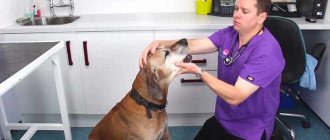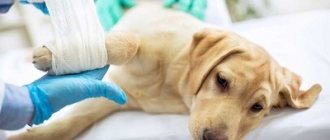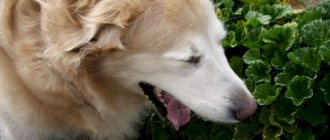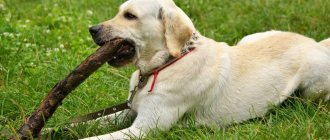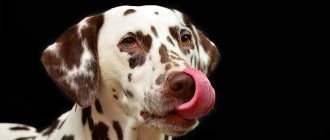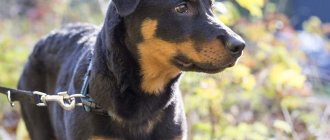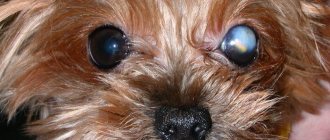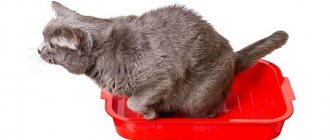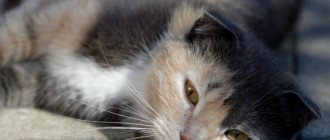Most people who have ever seen a pug are sure that it is a constantly grunting and sniffling dog. This is partly true, pugs have the ability to grunt and have fairly heavy breathing. This is explained by the structural features of the animal’s muzzle. However, grunting can often indicate serious health problems. Therefore, owners of pets of this breed need to be attentive to the well-being of their pet.
Typical Pug Diseases
If the dog for some reason began to limp, although there were no injuries, aseptic necrosis of the femoral head is possible, i.e., poor circulation of the femurs. Often the disease affects both hind legs. The pug becomes inactive, reacts painfully to touching its paw, and it begins to fail. Later, the necrotic process affects the entire limb: the muscles on the affected paws dry out.
Treatment is only possible with surgery, but mobility returns soon after surgery. Pugs are genetically predisposed to such limb problems. You should act quickly before your paws give out. A problem in small dogs is necrotizing meningoencephalitis: inflammation of the central nervous system. Manifested by convulsions, involuntary movements of the pupils, paralysis. Aggressive immunosuppressive treatment is required.
A deadly disease is pug encephalitis. The animal experiences seizures similar to epilepsy, its legs give way, its head twitches, tremors and convulsions occur. Encephalitis can develop due to a tick bite, but often the cause cannot be found.
It is believed that this disease may also be hereditary. In middle-aged and elderly bitches, the uterus may become inflamed. This provokes frequent urination, severe thirst, and lethargy. Purulent discharge from the loop is possible. Urgent treatment is necessary, sometimes it is necessary to resort to removal of the uterus and ovaries.
Pugs often grunt and cough: the reason is the so-called. brachycephalic syndrome in pugs, caused by a long palate with a short muzzle. In this case, the dog may have difficulty breathing, grunting, due to heat and fatigue (pugs often begin to choke at the end of a long walk), as well as illness (runny nose, etc.). A pug often grunts when it feels happy or stressed. The tendency to this problem is also hereditary: if the parents often suffocated, the puppies will also be prone to this.
If a dog coughs as if he is choking, this is a “reverse sneeze” - the dog is trying to clear his airways. This cough can be similar to gagging, and sometimes actually turns into vomiting. Periodically, this cough occurs in many dogs with a short muzzle and goes away on its own, but if the attacks become more frequent, consultation with a specialist is necessary. The dog could either simply catch a cold or become seriously ill, including heart problems. It is also worth checking whether a choking dog has foreign objects in the nasopharynx.
Similar article: What to buy and how to make clothes for a pug with your own hands
If a pug snores, it may be a genetic trait (about 20% of pugs snore, another manifestation of brachycephalic syndrome). But if this has not happened before, the cause of snoring may be an allergic runny nose, a cold, excess weight, sleep apnea, when the dog suffocates for a moment, etc. If your pug snores with frequent choking or coughing, you should consult a veterinarian. which will tell you whether it is necessary to eliminate the allergic factor, treat a runny nose or undergo surgery.
A cough and runny nose themselves can either mean that the dog has a slight cold or be symptoms of an infection. For example, “kennel cough” occurs after contact with other dogs: exhibitions, training on the site, etc. A runny nose and sneezing, which causes snot, can occur due to allergies. One of the common causes is also rhinitis - in this case, a runny nose, if you do not take active treatment, sometimes lasts for years. In all these cases, it is necessary to contact a veterinarian.
TOP 7 causes of snoring
Why does a dog snore and grunt? There are TOP reasons that veterinarians most often have to deal with in practice.
Foreign bodies (polyps) in the nose
Polyps are neoplasms with a convex configuration, pink color, and are a benign form of tumor that is not capable of metastasizing. They develop from the mucous membranes lining the sinuses. Symptoms of the presence of polyps can imitate respiratory pathologies, but when treated with antibiotics they do not disappear, but progress.
Solid foreign bodies (balls, buttons, etc.) often get into the nasopharynx, nose, get stuck there and interfere with the passage of air. The dog breathes heavily and snores, discharges often appear, first serous-mucous, then cloudy, purulent.
If a foreign body is suspected, the dog is x-rayed and the location and nature of the object is determined. They can only be removed surgically, using an endoscope (rhinoscope). If the foreign body is close to the exit of the nostrils, you can remove it with tweezers. Then the nasal sinuses are washed and the inflammation is stopped with the help of antiseptics and antibiotics.
For polyps, the dog is put under anesthesia so that the veterinarian can examine the palate and upper part of the mouth. The optimal choice is rhinoscopy (flexible endoscope), which allows you to visualize the image on the screen and, if necessary, take a biopsy to confirm the benign nature of the tumors.
Eye diseases
Eye diseases are very common in pugs. Eyeball prolapse looks especially scary when it bulges greatly and turns red (this happens due to a blow or an insect bite). What to do in this case? Apply a damp cloth to the dog’s eye and immediately go to the hospital.
If folds of skin touch the cornea, keratitis develops: the eye turns red and ulcers appear on it. Sometimes this causes pigmentation of the cornea, i.e. pigmentary keratitis. It is treated both surgically and with drops. Pigmentary keratitis sometimes occurs due to allergies. Cataracts (the dog bumps into objects due to deteriorating vision) and conjunctivitis (inflammation of the area around the eye) often develop. All eye sores in pugs require an immediate visit to the veterinarian, as they can lead to blindness.
Related article: How many years do pugs live and how to extend your pet’s life
Physiological features of toy terriers
The Toy Terrier is a small (also called “pocket”) dog, with an average height of 20-30 cm and an average weight of 1.5 to 3 kg.
live from 12 to 15 years . These pets are thin-boned, with high legs, square in shape with angular muscles. A wedge-shaped head, a rounded skull and a convex wide forehead are also characteristic features of the breed.
Read more about what Toy Terriers look like here.
To establish proper dog breathing, the transverse cartilaginous half-rings of the trachea provide the necessary rigidity so that the trachea does not collapse during inhalation, and the softer parts ensure its plasticity.
Ear diseases
Pug diseases affecting the ears are very common. Constant scratching of the ears, their swelling, elevated temperature and lethargy of the pet, as well as mucus discharge from the ears often indicate otitis media. To avoid inflammation, your pet's ears should be cleaned regularly.
This disease can also be a consequence of a cold. Symptoms such as hot, inflamed ears, the appearance of ulcers and crusts on them are often caused by microscopic ear mites. An accurate diagnosis must be made by a veterinarian. Anti-tick medications can cause side effects and should not be used without prior consultation.
When scratching the ear, do not use iodine - it will burn the tissue. It is better to wipe the wound with brilliant green or hydrogen peroxide. An insect can get into the ears - in this case, the dog often shakes its head. To begin, lay the animal on its side and drip vegetable oil into the ear. If the insect floats up, remove it with a cotton swab; if not, contact your veterinarian, but do not try to remove it yourself, otherwise you may push it deeper.
Helping a Snoring Dog
If your pet is not brachycephalic, but for some reason snores in its sleep, it is better to consult a veterinarian. Take your dog for a full examination and get all tests done. If you find a disease, treat your pet.
Protect your dog from unnecessary stress, it also provokes snoring. For simple cases (for docile animals), there are throat rinses in the form of aerosols.
The veterinarian declared the dog completely healthy, but the snoring problem has not disappeared? Carefully review your pet's daily exercise, its diet and environment. Try to walk him away from noisy roads, and do not go near trash cans or places where hazardous waste accumulates.
Put your dog on a diet, eliminating sweets and foods that are harmful to human friends from the diet. But you cannot deprive your four-legged pet of the required daily dose of vitamins and microelements. Otherwise, instead of solving the problem with snoring, you will get a new bunch of diseases.
Place to sleep
Observe how the dog sleeps, in what position, and whether it fits comfortably on the bed. Ideally, the animal should fit completely in its place, with its legs extended. Snoring can occur from an awkward position or when the head hangs down.
It is recommended to ventilate the room before going to bed for a good sleep for humans, but this procedure will not hurt animals either. The second important aspect in the fight against snoring is normal temperature and humidity. Sleeping in a too hot, stuffy room is not good for either people or dogs.
Skin diseases
If a pug's hair is falling out, the cause may be juvenile demodicosis - a tick infection that most often attacks this particular breed of dog. In addition to progressive baldness, demodicosis in a pug leads to the appearance of ulcers, wounds, and subsequently purulent abscesses and scabs on the body. Treatment is usually comprehensive, including adjustments to diet and walking patterns to strengthen the immune system. This disease usually appears in puppies up to one year old.
Pimples in pugs are often caused by allergies. If they are red, with a dot in the center, the most likely cause is fleas. A logical question: how to remove fleas? To do this, use special shampoos, collars or sprays. The apartment should also be disinfected.
Atopic dermatitis causes itchy, inflamed areas on the face, armpits, between the toes and around the anus. Many breeds are genetically predisposed to it, but the catalysts for the disease are food allergens, pollen, house dust, etc. This disease should be treated by subcutaneous injection of the allergen in gradually increasing concentrations. All procedures are carried out exclusively in the veterinary hospital. It is important to keep the skin inside the folds clean, otherwise inflammation may occur. The muzzle especially needs such care.
Similar article: How to name a boy or girl pug
Breeds prone to snoring
More often these are brachycephalic dogs, pets whose cranium is artificially shortened to give it a rounded, flat appearance. Breeders thought it was interesting, breeders thought it was funny, but veterinarians didn't share their enthusiasm. With the shortening of the bones, the soft tissues remained in the same volume; the “folding” and sagging of the soft palate helps to block the narrow path for air between the nose and throat. The air can cause tissue to vibrate and vibrate, which is called snoring.
What dog breeds often snore:
- Bulldogs (French, English).
- Pug, boxer.
- Chow chow, Pekingese.
- Bullmastiff.
- Shih Tzu, Chihuahua.
Among the rare breeds found in the Russian Federation are the Lhasa Apso, Boston Terrier and King Charles Spaniel.
Gastrointestinal tract dysfunction
Diarrhea in a pug can occur due to poisoning, unhealthy or unusual food, or infection. Sometimes diarrhea occurs due to nervous excitement or hypothermia. In this case, it is recommended to give the dog an enema, and until the diarrhea goes away, feed it exclusively with rolled oatmeal decoction.
If diarrhea is accompanied by vomiting, your dog should be given plenty of water or syringed to prevent dehydration. If diarrhea becomes chronic, it may be a symptom of colitis or gastritis (as evidenced by severe drooling).
Constipation often occurs due to poor diet, lack of water or a sedentary lifestyle. Sometimes constipation can be caused by an overdose of astringents during diarrhea. More dangerous causes of constipation are prostatitis and intestinal obstruction. In severe cases, treatment of constipation requires surgery. Pugs are prone to obesity. In addition to frequent constipation, excess weight aggravates breathing problems: obese pugs choke almost all the time.
Often, a pug snores due to fat folds on the neck.
If your pug is drooling a lot, it could be a sign of dental problems. Excessive salivation in transport indicates that the pet is seasick. The puppy needs to be accustomed to the car, gradually increasing the duration of the trips.
We recommend this article:
Treatment and prevention of giardiasis in dogs
It's all about the extra pounds
Just as overweight people are known for "heavy breathing and snoring," when a dog packs on extra pounds, snoring can be just as noisy. But why do chubby dogs seem to snore more? In this case, it seems to be a matter of where their fat is stored.
This extra layer of fat, found in a dog's chest, can put pressure on the dog's airways in certain sleeping positions, causing noise, explains veterinarian Lowell Ackerman.
Fortunately, a weight loss program can ultimately reduce snoring, as well as provide several other beneficial benefits that come with shedding a few pounds.
Urolithiasis disease
Signs of urolithiasis are as follows: the dog urinates frequently, the urine becomes cloudy, sometimes with pus. The animal becomes lethargic and apathetic, often licking its genitals. May urinate at home. In this case, treatment is necessary, since it is very difficult to wean a sick dog from peeing at home. First, diuretics are prescribed; further treatment depends on the size and nature of the stones. Surgery is often necessary.
Why is the dog trembling and panting: the most common reasons
Increased breathing during sleep can occur due to diseases of the cardiovascular and respiratory systems. In addition, if a dog sleeps in an awkward position, its upper palate may recede, which causes both snoring and rapid breathing.
Owners of small dogs, such as the Yorkshire Terrier, often experience rapid breathing. Most often, such dogs are kept as a home pillow or toy.
Important! If the dog is so weak that it cannot stand up, diagnosis and treatment at home is unacceptable.
The dog may tremble when experiencing strong emotions. Most often, trembling occurs due to fear. Heatstroke and fever cause the blood to thicken. Tremor in this case is a natural reaction of the body associated with an attempt to push clotted blood through narrowed vessels.
Video “Diseases of pugs”
From this video you will learn what diseases pugs can suffer from.
Recommended Posts
Features of estrus and rules for mating pugs
Tips for proper care of pugs
What you can and cannot feed your pug
Symptoms and treatment of German Shepherd diseases
History of the appearance and characteristics of the mini-pug breed
Symptoms and treatment options for arthritis and related joint diseases in dogs
Leaders in snoring
The list includes a significant portion of dogs belonging to the brachycephalic type. Their snoring regularly “delights” the ears of their owners.
Here is a list of breeds that are more likely to snore than others:
- pug;
- bulldog;
- Pekingese;
- Japanese Chin;
- Shar Pei.
The full list would be very long. It will include a small Spitz and a huge Cane Corso. The latter “knows how” to snore like an adult man, the reason is a shortened muzzle and a weakened palate.
Small French bulldogs sniffle and constantly grunt in their sleep. The miniature Chihuahua snores loudly, surprising strangers with its power.
German shepherds and Rottweilers begin to frighten their owners only when they reach a considerable age, by dog standards.
Symptoms of illness
Signs of poor health in pugs depend entirely on the disease. The main symptoms that your pet is sick are: diarrhea, vomiting, itching, redness and inflammation of the eyes and ears.
Correct and timely diagnosis is the key to quick and successful treatment of your pet..
If there are signs of poisoning, then the animal's droppings are taken for analysis.
You can diagnose any skin diseases by scraping the epithelium on the affected area of your pet's skin.
In case of injuries, as well as in cases where the animal’s paws fail, it is recommended to take an x-ray.
Encephalitis
Encephalitis is a neurological disease, inflammation of the brain caused by pathogens. The charming pug suffers from this disease quite often. It can cause convulsions, poor coordination of the animal’s movements, and provoke aggression or lethargy unusual for the breed.
Pug encephalitis usually appears in adulthood. There is no information about the cause of the disease and, to the deepest regret of the owners, this is a disease that cannot be cured by any means. The most you can do to help your pet is to give him corticosteroids (anti-inflammatory hormones) to reduce the tumor.
Therapy
Treatment of asthma in a dog begins with finding and eliminating the allergen. Low quality food, moldy foods, dishes with excess salt and vegetable proteins, and wheat concentrates are excluded from the dog’s menu. The diet is radically revised, enriched with missing microelements and B vitamins.
To stop attacks, a set of measures is used:
- oxygen therapy;
- adrenomimetic drugs (Adrenaline, Teofedrine);
- antispasmodics (Cordarone, Papaverine);
- antihistamines (Intal, Diprazine);
- hormonal drugs (Cortisone acetate, Metipred, Beclomet);
- restorative medications (Calcium gluconate).
How to treat asthma in dogs at home, before the veterinarian arrives? An oxygen mask will help alleviate the condition of a tailed asthmatic during an attack. The owner must keep it at home in case of force majeure. A timely injection of Theophedrine or Ephedrine will help quickly restore impaired breathing.
In addition, in the house where an asthmatic dog lives, there should always be vasodilators and antispasmodics (Papaverine, Eufillin), as well as decongestants (Suprastin, Diphenhydramine).
Veterinarians advise taking relaxing menthol inhalations when a seizure approaches. To clear the lumen of the bronchi from mucus, it is recommended to give drugs with an expectorant effect.
Particular attention should be paid to concomitant infectious diseases. If you have sinusitis, you should undergo antibiotic therapy. If polynosis is detected in the nose, you will have to resort to surgical intervention.
